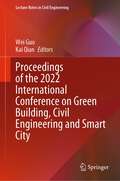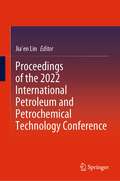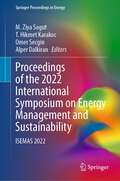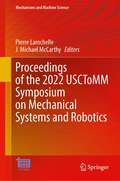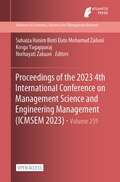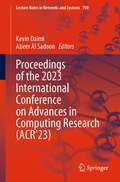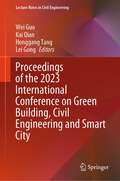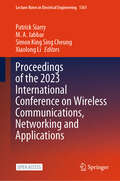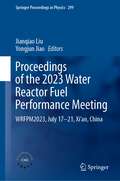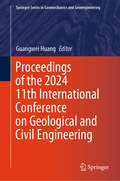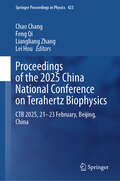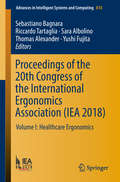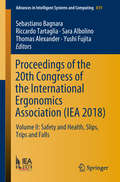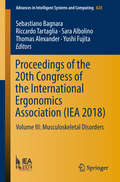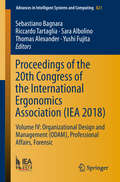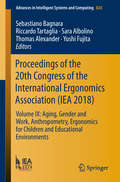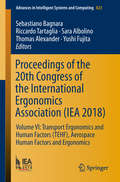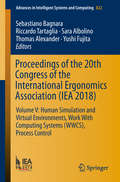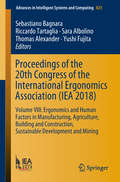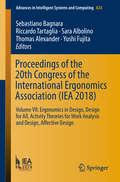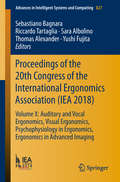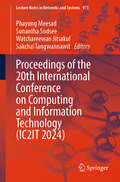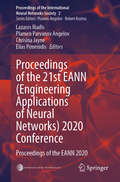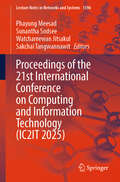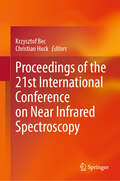- Table View
- List View
Proceedings of the 2022 International Conference on Green Building, Civil Engineering and Smart City (Lecture Notes in Civil Engineering #211)
by Kai Qian Wei GuoThis book of the conference proceedings focuses on innovative design, technology and methods in the fields of building, civil engineering and smart city. It contains a large number of detailed design, construction and performance analysis charts, benefited to students, teachers, research scholars and other professionals in related fields. As well, readers will encounter new ideas for realizing more safe, intelligent and economical buildings.
Proceedings of the 2022 International Petroleum and Petrochemical Technology Conference
by Jia’en LinThis book is a compilation of selected papers from the 6th International Petroleum and Petrochemical Technology Conference (IPPTC 2022). The work focuses on petroleum & petrochemical technologies and practical challenges in the field. It creates a platform to bridge the knowledge gap between China and the world. The conference not only provides a platform to exchanges experience but also promotes the development of scientific research in petroleum & petrochemical technologies. The book will benefit a broad readership, including industry experts, researchers, educators, senior engineers and managers.
Proceedings of the 2022 International Symposium on Energy Management and Sustainability: ISEMAS 2022 (Springer Proceedings in Energy)
by T. Hikmet Karakoc M. Ziya Sogut Alper Dalkiran Omer SecginThe International Symposium on Energy Management and Sustainability (ISEMAS) is a multi-disciplinary symposium that presents research on current issues in energy efficiency, social awareness, and global climate change. The conference provides a platform offering insights on the latest trends and innovations in energy management and the impact of sustainability on energy management processes. In this context, it aims to bring together sectoral, scientific, and demand-related elements in the field of energy. ISEMAS allows researchers, scientists, engineers, practitioners, policymakers, and students to exchange information, present new technologies and developments, and discuss future direction, strategies and priorities that improve environmental sustainability.
Proceedings of the 2022 USCToMM Symposium on Mechanical Systems and Robotics (Mechanisms and Machine Science #118)
by Pierre Larochelle J. Michael McCarthyThis volume gathers the latest fundamental research contributions, innovations, and applications in the field of design and analysis of complex robotic mechanical systems, machines, and mechanisms, as presented by leading international researchers at the 2nd USCToMM Symposium on Mechanical Systems and Robotics (USCToMM MSR), held in Rapid City, South Dakota, USA on May 19-21, 2022. It covers highly diverse topics, including soft, wearable and origami robotic systems; applications to walking, flying, climbing, underground, swimming and space systems; human rehabilitation and performance augmentation; design and analysis of mechanisms and machines; human-robot collaborative systems; service robotics; mechanical systems and robotics education; and the commercialization of mechanical systems and robotics. The contributions, which were selected by means of a rigorous international peer-review process, highlight numerous exciting and impactful research results that will inspire novel research directions and foster multidisciplinary research collaborations among researchers from around the globe.
Proceedings of the 2023 4th International Conference on Management Science and Engineering Management (Advances in Economics, Business and Management Research #259)
by Norhayati Zakuan Suhaiza Hanim Binti Dato Mohamad Zailani Kosga YagapparajThis is an open access book.Management science aims to study the dynamic study of human use of limited resources in management activities to achieve organizational goals: complex and innovative social behavior and its laws. And engineering management refers to the management of important and complex new products, equipment and devices in the process of development, manufacturing and production, and also includes the study and management of technological innovation, technological transformation, transformation, transformation, layout and strategy of industrial engineering technology development.The development or breakthrough of management theory is accompanied by the development and progress of science and technology, and the level of science and technology and the level of management theory in each historical period are mutually adaptive, and it can be said that the progress of science and technology plays an important role in promoting the development of management. At the same time, the rapid development and progress of science and technology give a strong injection to the development of engineering, and provide the possibility for engineering construction can use new technology, new equipment, new technology and new materials.Modern management is an important development direction of management science nowadays. And the use of modern management in engineering has an important role in saving social costs, ensuring project quality, and improving safety awareness and behavior.ICMSEM 2023 will focus on modern management, discuss about the benefits that modernization brings to engineering. ICMSEM 2023 aims to:Develop and advance management science through the study and application of certain issues.Open up new perspectives in the sharing of speakers and inspire the audience to new ways of managing in engineering.Create a forum for sharing, research and exchange at the international level, so that the participants can be informed of the latest research directions, results and contents of management science, which will inspire them to new ideas for research and practice.
Proceedings of the 2023 International Conference on Advances in Computing Research (Lecture Notes in Networks and Systems #700)
by Kevin Daimi Abeer Al SadoonThis book includes recent research on Data Science, IoT, Smart Cities and Smart Energy, Health Informatics, and Network Security. The International Conference on Advances in Computing Research (ACR’23) brings together a diverse group of researchers from all over the world with the intent of fostering collaboration and dissemination of the advances in computing technologies. The conference is aptly segmented into six tracks to promote a birds-of-the-same-feather congregation and maximize participation. The first track covers computational intelligence, which include, among others, research topics on artificial intelligence, knowledge representation and management, application and theory of neural systems, fuzzy and expert systems, and genetic algorithms. The second track focuses on cybersecurity engineering. It includes pertinent topics such as incident response, hardware and network security, digital biometrics and forensics technologies, and cybersecurity metrics and assessment. Further, it features emerging security technologies and high-tech systems security. The third track includes studies on data analytics. It covers topics such as data management, statistical and deep analytics, semantics and time series analytics, and a multitude of important applications of data analytics in areas such as engineering, health care, business, and manufacturing. The fourth track on network and communications covers a wide range of topics in both areas including protocols and operations, ubiquitous networks, ad hoc and sensor networks, cellular systems, virtual and augmented reality streaming, information centric networks, and the emerging areas in connected and autonomous vehicle communications. Lastly, the final track on cloud and mobile computing includes areas of interest in cloud computing such as infrastructure, service, management and operations, architecture, and interoperability and federation. This track also includes important topics in mobile computing such as services and applications, communication architectures, positioning and tracking technologies, the general applications of mobile computing.
Proceedings of the 2023 International Conference on Green Building, Civil Engineering and Smart City (Lecture Notes in Civil Engineering #328)
by Kai Qian Lei Gong Wei Guo Honggang TangThe book gathers the emerging technologies and applications in various disciplines involving green building, smart infrastructure and 3D Printing, which are presented in high-quality papers of GBCESC. Moreover, by sharing knowledge and experiences around emerging civil engineering and smart city, the book aims to provide readers with an overview of the emerging trends in the fields of green building, Civil Engineering and Smart City. The topics covered include Structural Engineering, Geological Engineering, Smart Cities, Urban Planning and Design, Construction Technology, green building technology, etc. This book will be useful for researchers and professionals in designing, building, and managing sustainable buildings and infrastructure.
Proceedings of the 2023 International Conference on Wireless Communications, Networking and Applications (Lecture Notes in Electrical Engineering #1361)
by Patrick Siarry Xiaolong Li M. A. Jabbar Simon King Sing CheungThis open access book includes original, peer-reviewed research papers from the 2023 International Conference on Wireless Communications, Networking and Applications (WCNA 2023), held in Shenzhen, Guangdong, China, from December 29 to 31, 2023. The topics covered include but are not limited to: Wireless Communications; Devices, Tools, and Techniques for WSN and Other Wireless Networks; Wireless Sensor Networks; Internet of Things (IoT); AI; Signal Processing; and Sustainable Pervasive WSN Applications. The papers showcased here share the latest findings on Wireless Communications, Networking and Applications, making the book a valuable asset for researchers, scientists, scholars, engineers and students from the universities all around the world and the industry.
Proceedings of the 2023 Water Reactor Fuel Performance Meeting: WRFPM2023, July 17–21, Xi’an, China (Springer Proceedings in Physics #299)
by Jianqiao Liu Yongjun JiaoThe Water Reactor Fuel Performance Meeting (WRFPM) held in Asia has merged with TopFuel in Europe and LWR Fuel Performance in the United States to form the globally most influential conference in the field of nuclear fuel research. WRFPM2023 is organized by Chinese Nuclear Society (CNS) in cooperation with the Atomic Energy Society of Japan (AESJ), Korean Nuclear Society (KNS), European Nuclear Society (ENS), American Nuclear Society (ANS), the Interna-tional Atomic Energy Agency (IAEA) with the support from China Nuclear Energy In¬dustry Corporation (CNEIC) and TVEL.Conference Topics:1. Advances in water reactor fuel technology and testing2. Operation and experience3. Transient and off-normal fuel behaviour and safety related issues4. Fuel cycle, used fuel storage and transportation5. Innovative fuel and related issues6. Fuel modelling, analysis and methodology
Proceedings of the 2024 11th International Conference on Geological and Civil Engineering (Springer Series in Geomechanics and Geoengineering)
by Guangwei HuangThis book is a collection of peer-reviewed and presented papers from the 2024 11th International Conference on Geological and Civil Engineering. The event was held in Matsue City, Japan, March 15–17, 2024, which provided a platform for researchers, engineers, academicians, as well as industrial professionals from all over the world to present their latest research results and development activities in geological and civil engineering. As a result, various topics were discussed in this book, including geological engineering, geotechnical engineering, civil and structural engineering, bridge engineering, building structure and bridge engineering, building technology, cartography and geographic information system, coastal engineering, surveying and geo-informatics, surveying and photogrammetry, tunnel, subway construction, underground facilities, and urban planning. The research outcomes included in this book are useful for better understanding what issues geological and civil engineering researchers are currently concerned with and what are frontiers in research approaches and technology advancement to meet the challenges today. It also provided various hints and inspirations for young researchers and engineers to pursue excellence.
Proceedings of the 2025 China National Conference on Terahertz Biophysics: CTB 2025, 21–23 February, Beijing, China (Springer Proceedings in Physics #423)
by Feng Qi Lei Hou Chao Chang Liangliang ZhangThis book highlights reviews, perspectives, and original research that contribute to the advanced interdisciplinary studies of theories, technologies, and strategies on THz sensing, biophysics, communications, and bio-effect research. The terahertz (THz) frequency covers a spectrum important for applications such as body security, non-destructive matter sensing, bio-imaging, and bio-medicine. It overlaps with the characteristic fingerprints of molecular vibrations and rotations (e.g., proteins and DNA) and thus could resonantly interact with various bio-matters. The 2021 Nobel Prize in medicine was granted for the discovery of ion channels of temperature and pressure sensing. The frequency of THz makes it absorbable for bio-effect and modulation of bio-molecules, especially for ion channels. Besides, the high-speed modulation in terahertz is a holy grail for integrated photonics in high-capacity computations. This topic has raised widespread interest in fundamental science and applications for THz. The proceedings are suitable for researchers and students interested in interdisciplinary research at the intersection of electromagnetics, physics, and life sciences.
Proceedings of the 20th Congress of the International Ergonomics Association: Volume I: Healthcare Ergonomics (Advances in Intelligent Systems and Computing #818)
by Thomas Alexander Sebastiano Bagnara Riccardo Tartaglia Sara Albolino Yushi FujitaThis book presents the proceedings of the 20th Congress of the International Ergonomics Association (IEA 2018), held on August 26-30, 2018, in Florence, Italy. By highlighting the latest theories and models, as well as cutting-edge technologies and applications, and by combining findings from a range of disciplines including engineering, design, robotics, healthcare, management, computer science, human biology and behavioral science, it provides researchers and practitioners alike with a comprehensive, timely guide on human factors and ergonomics. It also offers an excellent source of innovative ideas to stimulate future discussions and developments aimed at applying knowledge and techniques to optimize system performance, while at the same time promoting the health, safety and wellbeing of individuals. The proceedings include papers from researchers and practitioners, scientists and physicians, institutional leaders, managers and policy makers that contribute to constructing the Human Factors and Ergonomics approach across a variety of methodologies, domains and productive sectors. This volume includes papers addressing Healthcare Ergonomics.
Proceedings of the 20th Congress of the International Ergonomics Association: Volume II: Safety and Health, Slips, Trips and Falls (Advances in Intelligent Systems and Computing #819)
by Thomas Alexander Sebastiano Bagnara Riccardo Tartaglia Sara Albolino Yushi FujitaThis book presents the proceedings of the 20th Congress of the International Ergonomics Association (IEA 2018), held on August 26-30, 2018, in Florence, Italy. By highlighting the latest theories and models, as well as cutting-edge technologies and applications, and by combining findings from a range of disciplines including engineering, design, robotics, healthcare, management, computer science, human biology and behavioral science, it provides researchers and practitioners alike with a comprehensive, timely guide on human factors and ergonomics. It also offers an excellent source of innovative ideas to stimulate future discussions and developments aimed at applying knowledge and techniques to optimize system performance, while at the same time promoting the health, safety and wellbeing of individuals. The proceedings include papers from researchers and practitioners, scientists and physicians, institutional leaders, managers and policy makers that contribute to constructing the Human Factors and Ergonomics approach across a variety of methodologies, domains and productive sectors. This volume includes papers addressing the following topics: Safety and Health, and Slips, Trips and Falls.
Proceedings of the 20th Congress of the International Ergonomics Association: Volume III: Musculoskeletal Disorders (Advances in Intelligent Systems and Computing #820)
by Thomas Alexander Sebastiano Bagnara Riccardo Tartaglia Sara Albolino Yushi FujitaThis book presents the proceedings of the 20th Congress of the International Ergonomics Association (IEA 2018), held on August 26-30, 2018, in Florence, Italy. By highlighting the latest theories and models, as well as cutting-edge technologies and applications, and by combining findings from a range of disciplines including engineering, design, robotics, healthcare, management, computer science, human biology and behavioral science, it provides researchers and practitioners alike with a comprehensive, timely guide on human factors and ergonomics. It also offers an excellent source of innovative ideas to stimulate future discussions and developments aimed at applying knowledge and techniques to optimize system performance, while at the same time promoting the health, safety and wellbeing of individuals. The proceedings include papers from researchers and practitioners, scientists and physicians, institutional leaders, managers and policy makers that contribute to constructing the Human Factors and Ergonomics approach across a variety of methodologies, domains and productive sectors. This volume includes papers addressing Musculoskeletal Disorders.
Proceedings of the 20th Congress of the International Ergonomics Association: Volume IV: Organizational Design and Management (ODAM), Professional Affairs, Forensic (Advances in Intelligent Systems and Computing #821)
by Thomas Alexander Sebastiano Bagnara Riccardo Tartaglia Sara Albolino Yushi FujitaThis book presents the proceedings of the 20th Congress of the International Ergonomics Association (IEA 2018), held on August 26-30, 2018, in Florence, Italy. By highlighting the latest theories and models, as well as cutting-edge technologies and applications, and by combining findings from a range of disciplines including engineering, design, robotics, healthcare, management, computer science, human biology and behavioral science, it provides researchers and practitioners alike with a comprehensive, timely guide on human factors and ergonomics. It also offers an excellent source of innovative ideas to stimulate future discussions and developments aimed at applying knowledge and techniques to optimize system performance, while at the same time promoting the health, safety and wellbeing of individuals. The proceedings include papers from researchers and practitioners, scientists and physicians, institutional leaders, managers and policy makers that contribute to constructing the Human Factors and Ergonomics approach across a variety of methodologies, domains and productive sectors. This volume includes papers addressing Organizational Design and Management.
Proceedings of the 20th Congress of the International Ergonomics Association: Volume IX: Aging, Gender and Work, Anthropometry, Ergonomics for Children and Educational Environments (Advances in Intelligent Systems and Computing #826)
by Thomas Alexander Sebastiano Bagnara Riccardo Tartaglia Sara Albolino Yushi FujitaThis book presents the proceedings of the 20th Congress of the International Ergonomics Association (IEA 2018), held on August 26-30, 2018, in Florence, Italy. By highlighting the latest theories and models, as well as cutting-edge technologies and applications, and by combining findings from a range of disciplines including engineering, design, robotics, healthcare, management, computer science, human biology and behavioral science, it provides researchers and practitioners alike with a comprehensive, timely guide on human factors and ergonomics. It also offers an excellent source of innovative ideas to stimulate future discussions and developments aimed at applying knowledge and techniques to optimize system performance, while at the same time promoting the health, safety and wellbeing of individuals. The proceedings include papers from researchers and practitioners, scientists and physicians, institutional leaders, managers and policy makers that contribute to constructing the Human Factors and Ergonomics approach across a variety of methodologies, domains and productive sectors. This volume includes papers addressing the following topics: Aging, Gender and Work, Anthropometry, and Ergonomics for Children and Education.
Proceedings of the 20th Congress of the International Ergonomics Association: Volume VI: Transport Ergonomics and Human Factors (TEHF), Aerospace Human Factors and Ergonomics (Advances in Intelligent Systems and Computing #823)
by Thomas Alexander Sebastiano Bagnara Riccardo Tartaglia Sara Albolino Yushi FujitaThis book presents the proceedings of the 20th Congress of the International Ergonomics Association (IEA 2018), held on August 26-30, 2018, in Florence, Italy. By highlighting the latest theories and models, as well as cutting-edge technologies and applications, and by combining findings from a range of disciplines including engineering, design, robotics, healthcare, management, computer science, human biology and behavioral science, it provides researchers and practitioners alike with a comprehensive, timely guide on human factors and ergonomics. It also offers an excellent source of innovative ideas to stimulate future discussions and developments aimed at applying knowledge and techniques to optimize system performance, while at the same time promoting the health, safety and wellbeing of individuals. The proceedings include papers from researchers and practitioners, scientists and physicians, institutional leaders, managers and policy makers that contribute to constructing the Human Factors and Ergonomics approach across a variety of methodologies, domains and productive sectors. This volume includes papers addressing the following topics: Transport Ergonomics and Human Factors (TEHF), and Aerospace Human Factors and Ergonomics.
Proceedings of the 20th Congress of the International Ergonomics Association: Volume X: Auditory And Vocal Ergonomics; Visual Ergonomics; Psychophysiology; Ergonomics In Advanced Imaging (Advances In Intelligent Systems and Computing #827)
by Thomas Alexander Sebastiano Bagnara Riccardo Tartaglia Sara Albolino Yushi FujitaThis book presents the proceedings of the 20th Congress of the International Ergonomics Association (IEA 2018), held on August 26-30, 2018, in Florence, Italy. By highlighting the latest theories and models, as well as cutting-edge technologies and applications, and by combining findings from a range of disciplines including engineering, design, robotics, healthcare, management, computer science, human biology and behavioral science, it provides researchers and practitioners alike with a comprehensive, timely guide on human factors and ergonomics. It also offers an excellent source of innovative ideas to stimulate future discussions and developments aimed at applying knowledge and techniques to optimize system performance, while at the same time promoting the health, safety and wellbeing of individuals. The proceedings include papers from researchers and practitioners, scientists and physicians, institutional leaders, managers and policy makers that contribute to constructing the Human Factors and Ergonomics approach across a variety of methodologies, domains and productive sectors. This volume includes papers addressing the following topics: Human Simulation and Virtual Environments, Work With Computing Systems (WWCS), and Process Control.
Proceedings of the 20th Congress of the International Ergonomics Association: Volume X: Auditory And Vocal Ergonomics; Visual Ergonomics; Psychophysiology; Ergonomics In Advanced Imaging (Advances In Intelligent Systems and Computing #827)
by Thomas Alexander Sebastiano Bagnara Riccardo Tartaglia Sara Albolino Yushi FujitaThis book presents the proceedings of the 20th Congress of the International Ergonomics Association (IEA 2018), held on August 26-30, 2018, in Florence, Italy. By highlighting the latest theories and models, as well as cutting-edge technologies and applications, and by combining findings from a range of disciplines including engineering, design, robotics, healthcare, management, computer science, human biology and behavioral science, it provides researchers and practitioners alike with a comprehensive, timely guide on human factors and ergonomics. It also offers an excellent source of innovative ideas to stimulate future discussions and developments aimed at applying knowledge and techniques to optimize system performance, while at the same time promoting the health, safety and wellbeing of individuals. The proceedings include papers from researchers and practitioners, scientists and physicians, institutional leaders, managers and policy makers that contribute to constructing the Human Factors and Ergonomics approach across a variety of methodologies, domains and productive sectors. This volume includes papers addressing the following topics: Ergonomics in Manufacturing, Agriculture, Building and Construction, and Mining, and Human Factors and Sustainable Development.
Proceedings of the 20th Congress of the International Ergonomics Association: Volume X: Auditory And Vocal Ergonomics; Visual Ergonomics; Psychophysiology; Ergonomics In Advanced Imaging (Advances In Intelligent Systems and Computing #827)
by Thomas Alexander Sebastiano Bagnara Riccardo Tartaglia Sara Albolino Yushi FujitaThis book presents the proceedings of the 20th Congress of the International Ergonomics Association (IEA 2018), held on August 26-30, 2018, in Florence, Italy. By highlighting the latest theories and models, as well as cutting-edge technologies and applications, and by combining findings from a range of disciplines including engineering, design, robotics, healthcare, management, computer science, human biology and behavioral science, it provides researchers and practitioners alike with a comprehensive, timely guide on human factors and ergonomics. It also offers an excellent source of innovative ideas to stimulate future discussions and developments aimed at applying knowledge and techniques to optimize system performance, while at the same time promoting the health, safety and wellbeing of individuals. The proceedings include papers from researchers and practitioners, scientists and physicians, institutional leaders, managers and policy makers that contribute to constructing the Human Factors and Ergonomics approach across a variety of methodologies, domains and productive sectors. This volume includes papers addressing the following topics: Ergonomics in Design, Activity Theories for Work Analysis and Design, and Affective Design.
Proceedings of the 20th Congress of the International Ergonomics Association: Volume X: Auditory and Vocal Ergonomics, Visual Ergonomics, Psychophysiology in Ergonomics, Ergonomics in Advanced Imaging (Advances in Intelligent Systems and Computing #827)
by Thomas Alexander Sebastiano Bagnara Riccardo Tartaglia Sara Albolino Yushi FujitaThis book presents the proceedings of the 20th Congress of the International Ergonomics Association (IEA 2018), held on August 26-30, 2018, in Florence, Italy. By highlighting the latest theories and models, as well as cutting-edge technologies and applications, and by combining findings from a range of disciplines including engineering, design, robotics, healthcare, management, computer science, human biology and behavioral science, it provides researchers and practitioners alike with a comprehensive, timely guide on human factors and ergonomics. It also offers an excellent source of innovative ideas to stimulate future discussions and developments aimed at applying knowledge and techniques to optimize system performance, while at the same time promoting the health, safety and wellbeing of individuals. The proceedings include papers from researchers and practitioners, scientists and physicians, institutional leaders, managers and policy makers that contribute to constructing the Human Factors and Ergonomics approach across a variety of methodologies, domains and productive sectors. This volume includes papers addressing the following topics: Auditory and Vocal Ergonomics, Visual Ergonomics, Psychophysiology, and Ergonomics in Advanced Imaging.
Proceedings of the 20th International Conference on Computing and Information Technology (Lecture Notes in Networks and Systems #973)
by Phayung Meesad Sunantha Sodsee Watchareewan Jitsakul Sakchai TangwannawitThis book gathers the high-quality papers presented at the 20th International Conference on Computing and Information Technology (IC2IT2024), held on May 16-17, 2024, in Bangkok, Thailand. The book presents an original research work for both academic and industry domains, which is aiming to show valuable knowledge, skills and experiences in the field of computing and information technology. The topics covered in the book include natural language processing, image processing, intelligent systems and algorithms, as well as machine learning. These lead to the major research directions for innovating computational methods and applications of information technology.
Proceedings of the 21st EANN: Proceedings of the EANN 2020 (Proceedings of the International Neural Networks Society #2)
by Elias Pimenidis Chrisina Jayne Lazaros Iliadis Plamen Parvanov AngelovThis book gathers the proceedings of the 21st Engineering Applications of Neural Networks Conference, which is supported by the International Neural Networks Society (INNS). Artificial Intelligence (AI) has been following a unique course, characterized by alternating growth spurts and “AI winters.” Today, AI is an essential component of the fourth industrial revolution and enjoying its heyday. Further, in specific areas, AI is catching up with or even outperforming human beings. This book offers a comprehensive guide to AI in a variety of areas, concentrating on new or hybrid AI algorithmic approaches with robust applications in diverse sectors.One of the advantages of this book is that it includes robust algorithmic approaches and applications in a broad spectrum of scientific fields, namely the use of convolutional neural networks (CNNs), deep learning and LSTM in robotics/machine vision/engineering/image processing/medical systems/the environment; machine learning and meta learning applied to neurobiological modeling/optimization; state-of-the-art hybrid systems; and the algorithmic foundations of artificial neural networks.
Proceedings of the 21st International Conference on Computing and Information Technology (Lecture Notes in Networks and Systems #1390)
by Phayung Meesad Sunantha Sodsee Watchareewan Jitsakul Sakchai TangwannawitThis book gathers the high-quality papers presented at the 21st International Conference on Computing and Information Technology (IC2IT2025), held on May 15–16, 2025, in Kanchanaburi, Thailand. The book presents an original research work for both academic and industry domains, which is aiming to show valuable knowledge, skills and experiences in the field of computing and information technology. The topics covered in the book include natural language processing, image processing, image processing, intelligent systems and algorithms, as well as machine learning. These lead to the major research directions for innovating computational methods and applications of information technology
Proceedings of the 21st International Conference on Near Infrared Spectroscopy
by Christian Huck Krzysztof BecThe proceedings of 21st International Conference on Near Infrared Spectroscopy (NIR 2023 Innsbruck) presents a comprehensive collection of contributions of renowned researchers, scientists, and industry professionals who have converged to share their expertise and advancements at the NIR 2023 conference. Covering a wide range of topics, this volume reflects the outstanding versatility and practical importance of the potent analytical technique and its contemporary avenues. The proceedings summarize the groundbreaking research, novel instrumentation, and diverse applications in the field of NIR spectroscopy. The book explores the latest methods, techniques, and emerging trends in NIR spectroscopy that were presented and discussed at NIR 2023. It explores the underlying fundamental science, development of innovative instrumentation, methods as well as cutting-edge data analysis techniques, and their applications in key fields such as pharmaceuticals, food analysis, agriculture, biomedical diagnostics, and environmental monitoring. Each article within this volume represents current trends in the field of NIR spectroscopy, presenting original research and practical insights. Reflecting the topics of the premier NIR spectroscopy conference, this book forms an indispensable resource for researchers, practitioners, and students seeking to stay at the forefront of NIR spectroscopy. The hope is that the Proceedings of NIR 2023 will serve as a catalyst for further exploration, collaboration, and innovation in the dynamic realm of NIR spectroscopy.
